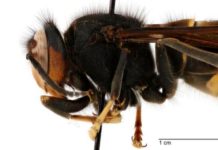
Jan. 1 (UPI) — Genetic mutations that fuel resistance to a drug intended to prevent malaria in pregnant women and children are common in countries that are fighting the disease, according to a PLOS Genetics analysis.
Mutations of a gene linked with resistance to the drug sulfadoxine-pyrimethamine in the parasite that causes malaria were discovered in one-fourth of the samples collected in southeast Asia and one-third of those obtained in Africa, the researchers said.
The growth in the number of malaria parasites with mutations to the gene pfgch1 are concerning because they may increase resistance to the drug, they said.
“We need to understand how these mutations work and monitor them as part of malaria surveillance programs,” study co-author Taane Clark, a professor of genomics and global health at the London School of Hygiene and Tropical Medicine, said in a statement.
Malaria causes more than 400,000 deaths worldwide annually, with most occurring in young children in sub-Saharan Africa, according to the World Health Organization.
Efforts to control the disease have been hampered by the rise of drug-resistant strains of the parasite species that causes the disease, according to Clark and his colleagues.
Sulfadoxine-pyrimethamine, once a first-line anti-malaria treatment, now is used primarily to prevent infection in pregnant women and children because the parasite Plasmodium falciparum has become resistant to it, the researchers said.
Malaria is spread when female Anopheles gambiae mosquitos carrying the parasite bite humans and feed on their blood, according to the researchers.
For the study, Clark and colleagues analyzed genome sequences from 4,134 blood samples of the Plasmodium falciparum parasite collected from 29 countries in which malaria is endemic.
They discovered at least 10 different versions of the gene in the samples, which they said indicates that strains carrying the mutations may be on the rise.
The growth in these mutations could threaten efforts to use sulfadoxine-pyrimethamine to prevent malaria in communities at high-risk for severe disease, the researchers said.
However, with the identification of these mutations, researchers may be able to monitor their presence in parasite populations to understand where the drug can be used effectively and where rates of drug-resistance already are too high.
That may be particularly crucial given that a separate analysis, also published Thursday by PLOS Pathogens, found that multiple bouts of blood feeding by malaria-carrying mosquitos shorten the incubation period for the virus and increase its transmission potential.
An additional blood feed three days after infection with Plasmodium falciparum accelerates the growth of the malaria parasite, shortening the incubation period required before transmission to humans can occur, the researchers said.
Given that mosquitoes feed on blood multiple times in natural settings, malaria transmission potential is likely higher than previously thought, making disease elimination more difficult, they said.
In addition, parasite growth is accelerated in genetically modified mosquitoes with reduced reproductive capacity, suggesting that control strategies using this approach, with the aim of suppressing Anopheles populations, may inadvertently aid malaria transmission, according to the researchers.
The parasites can also be transmitted by younger mosquitoes, which are less susceptible to insecticides, the researchers said.
The findings could help to more accurately understand malaria transmission potential and better estimate the true impact of current and future mosquito control measures, according to the researchers.
“We wanted to capture the fact that, in endemic regions, malaria-transmitting mosquitoes are feeding on blood roughly every two to three days,” study co-author W. Robert Shaw said in a statement.
“Our study shows that this natural behavior strongly promotes the transmission potential of malaria parasites, in previously unappreciated ways,” said Shaw, a research scientist at Harvard T.H. Chan School of Public Health.





